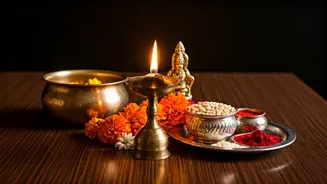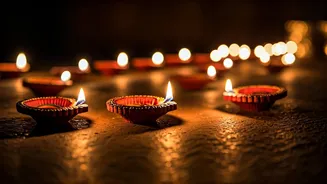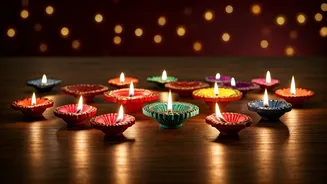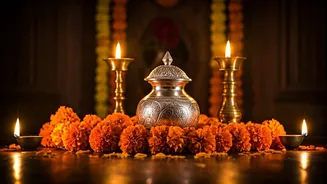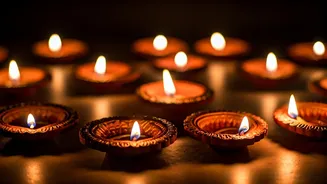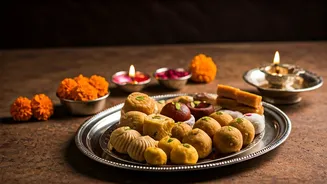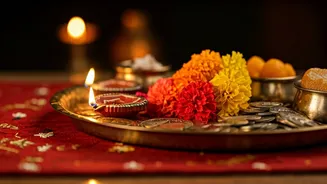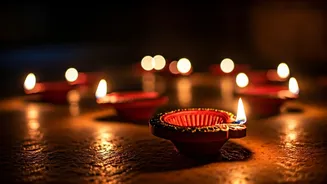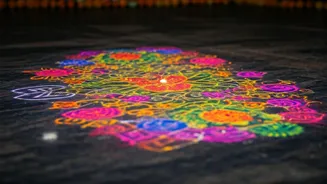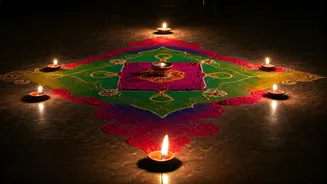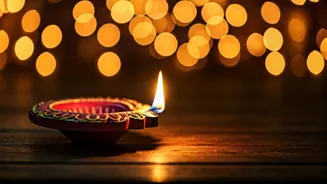Setting the Stage
To begin, find a clean and quiet space in your home dedicated to your Puja altar. This could be a dedicated room, a corner of a room, or a table specifically
for this purpose. The area should be meticulously cleaned and purified before setting up. Next, cover the surface with a clean cloth, preferably in a color associated with auspiciousness, such as red, yellow, or white. Consider using a wooden platform (Chowki) to elevate the altar; this adds a sense of reverence. The chosen location should be free from distractions and foot traffic. Preparing the physical space is the first step toward creating a sacred environment, setting the stage for the rituals to come.
Deities & Idols
The centerpiece of your Puja altar will be the idols or images of the deities. For Diwali, the primary deities are Goddess Lakshmi, the goddess of wealth and prosperity, and Lord Ganesha, the remover of obstacles. Position the idols in a way that allows you to clearly see and interact with them during your prayers. You might choose to add other deities based on your family traditions. Ensure the idols are clean and well-maintained. The placement should be such that you face the deities while praying. The presence of the deities establishes a connection with the divine, making it central to your Puja.
Essential Items
Your Puja altar requires a selection of essential items to conduct the rituals. This includes a diya (lamp) for lighting, incense sticks, and a small bell to ring during the prayers. You will also need containers for holy water (Gangajal), raw rice (Akshata), flowers, and sandalwood paste. Place these items neatly around the idols, ensuring they are easily accessible. A small container with prasad (sweets) is also essential. The arrangement of these items must be both aesthetically pleasing and functional. These items represent the various offerings made to the deities, contributing to a sense of devotion and reverence.
Preparing the Offerings
Before commencing the Puja, prepare the offerings. Arrange fresh flowers in a vase or directly on the altar. Prepare the Akshata by mixing rice with turmeric powder. Apply sandalwood paste (Chandana) to the idols. Light the diya and incense sticks. Place the prasad in front of the deities. The offerings should be fresh and presented with devotion. Offering these items is a gesture of love and respect toward the deities, contributing significantly to the sanctity of the Puja and setting the tone for a blessed Diwali.
Puja Procedures
Once everything is set up, begin the Puja by invoking Lord Ganesha for a smooth ceremony. Chant the appropriate mantras for the deities. Offer flowers, Akshata, and Chandana. Light the diya and incense and perform Aarti, circling the lit lamp in front of the idols while chanting prayers. Conclude with the distribution of prasad and blessings from the deities. The Pooja is a set of carefully executed rituals, each designed to invoke the divine, leading to prosperity and happiness.
Final Touches
After completing the Puja, take some time to reflect on the experience. Meditate on the blessings you have received and express gratitude. Keep the altar clean and tidy throughout Diwali. The area can be decorated with lights, rangoli, or other festive elements. The whole ambiance, including the clean arrangement of the altar, should be inviting and convey peace. These final touches enhance the spiritual significance, leaving you feeling centered and connected with the divine, setting the tone for a very auspicious Diwali.
